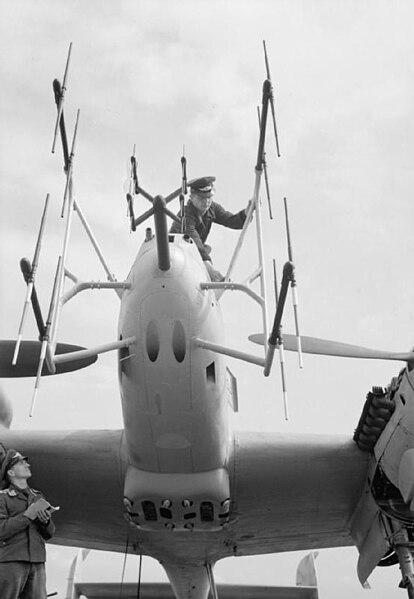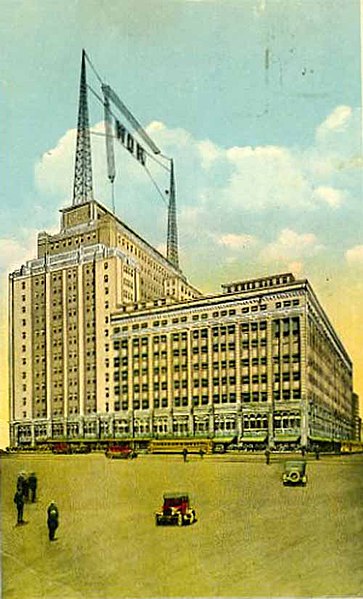A Yagi–Uda antenna, or simply Yagi antenna, is a directional antenna consisting of two or more parallel resonant antenna elements in an end-fire array; these elements are most often metal rods acting as half-wave dipoles. Yagi–Uda antennas consist of a single driven element connected to a radio transmitter or receiver through a transmission line, and additional passive radiators with no electrical connection, usually including one so-called reflector and any number of directors. It was invented in 1926 by Shintaro Uda of Tohoku Imperial University, Japan, with a lesser role played by his boss Hidetsugu Yagi.
A modern high-gain UHF Yagi television antenna with 17 directors, and one reflector (made of four rods) shaped as a corner reflector
Quartet of two-dipole Yagi arrays (Hirschgeweih) of the German FuG 220 VHF-band radar on the nose of a late-World War II Bf 110 night fighter aircraft
A portable Yagi–Uda antenna for use at 144 MHz (2 m), with segments of yellow tape-measure ribbon for the arms of the driven and parasitic elements.
Two Yagi–Uda antennas on a single mast. The top one includes a corner reflector and three stacked Yagis fed in phase in order to increase gain in the horizontal direction (by cancelling power radiated toward the ground or sky). The lower antenna is oriented for vertical polarization, with a much lower resonant frequency.
A directional antenna or beam antenna is an antenna which radiates or receives greater radio wave power in specific directions. Directional antennas can radiate radio waves in beams, when greater concentration of radiation in a certain direction is desired, or in receiving antennas receive radio waves from one specific direction only. This can increase the power transmitted to receivers in that direction, or reduce interference from unwanted sources. This contrasts with omnidirectional antennas such as dipole antennas which radiate radio waves over a wide angle, or receive from a wide angle.
A multi-element, log-periodic dipole array
A 70-meter Cassegrain radio antenna at GDSCC, California
An early example (1922) of a directional AM radio transmitter using a long wire antenna, built for WOR, then in Newark, New Jersey and targeting both New York City and Philadelphia in addition to Newark.
Holmdel Horn Antenna in Holmdel, New Jersey (1960s). Built to support the Echo satellite communication program, it was later used in experiments that revealed the Cosmic microwave background permeating the universe.








